Key takeaways:
- Online resource guides for dyslexia provide clarity and community support, helping users navigate overwhelming information.
- Effective dyslexia training emphasizes multisensory learning and self-advocacy, empowering individuals to thrive in various settings.
- When evaluating resources, credibility, user experience, and community features are crucial for effective learning.
- Choosing resources should prioritize personal learning styles, credibility, and feedback from community users to ensure effectiveness.
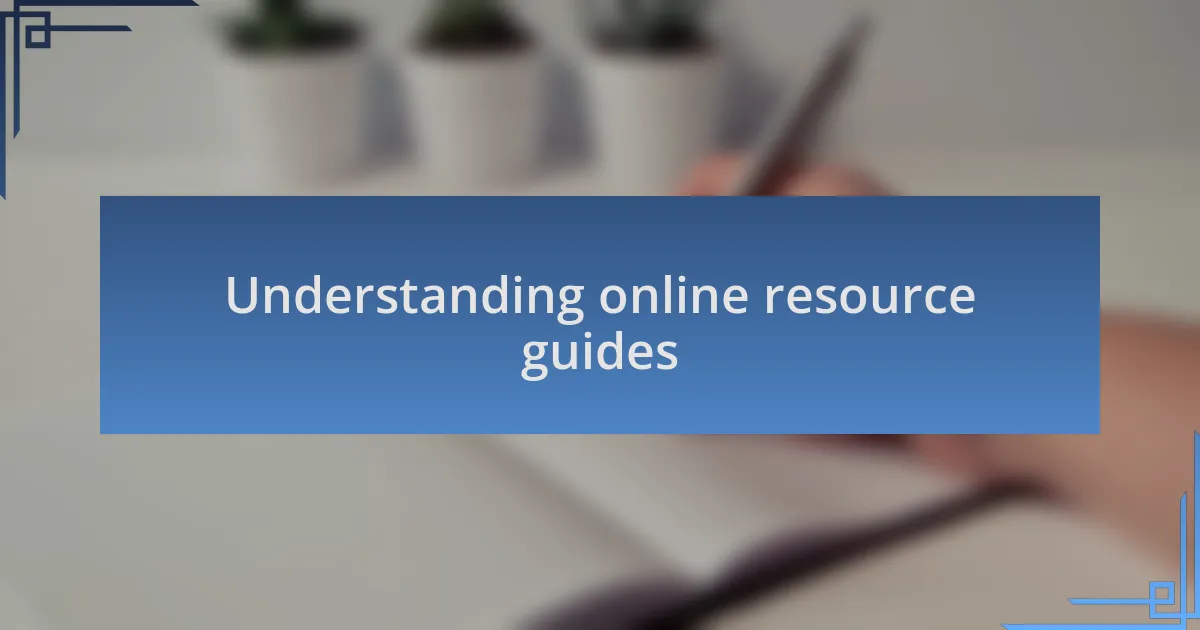
Understanding online resource guides
Online resource guides serve as invaluable tools for those navigating the complexities of dyslexia. I remember my initial struggles while searching for reliable information; I often felt overwhelmed by the mountains of resources available. Have you ever found yourself lost in information overload? That’s where well-structured online guides can make a significant difference, providing clarity and focus.
While some resources present a plethora of information, effective guides distill key concepts into manageable bites. From identifying specific coping strategies to exploring evidence-based interventions, these guides can illuminate pathways that might otherwise be hidden. I often refer back to my favorite online guide when I need quick answers—there’s something reassuring about knowing where to find reliable information, isn’t there?
Moreover, the emotional aspect of using these guides shouldn’t be underestimated. I recall the feeling of hope that washed over me when I discovered a guide that resonated with my experiences. It made me realize that I wasn’t alone in this journey. Engaging, informative guides can foster a sense of community, inviting individuals to share their experiences and strategies. How empowering is that?
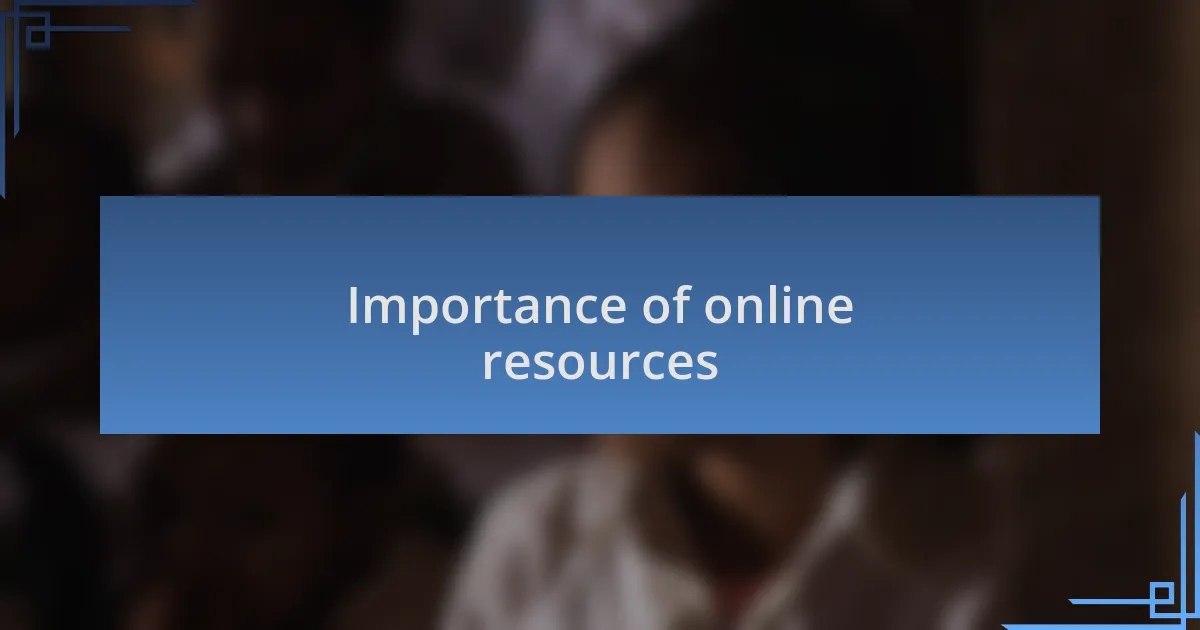
Importance of online resources
Online resources play a crucial role in making information accessible and user-friendly for individuals dealing with dyslexia. I recall the times I encountered complex studies or jargon-heavy articles that left me feeling even more confused. How often do we need guidance that speaks our language? It’s refreshing to find resources that break down difficult concepts into digestible pieces, making learning a less daunting experience.
In my journey, I’ve found that well-organized online resources can serve as lifelines during critical moments. For instance, I once stumbled upon a site with a forum where individuals shared personal strategies and successes. It felt like a warm embrace, knowing that others faced similar challenges. Have you ever been part of a community that offered encouragement just when you needed it? That connection can motivate you to keep pushing forward.
The evolving nature of online resources also means they can be updated frequently, ensuring that users are equipped with the latest techniques and strategies. I remember feeling reassured when I discovered an updated guide that featured new interventions based on the latest research. How powerful it is to have access to cutting-edge information right at our fingertips! These resources not only inform but also inspire ongoing growth and adaptability in our learning journeys.
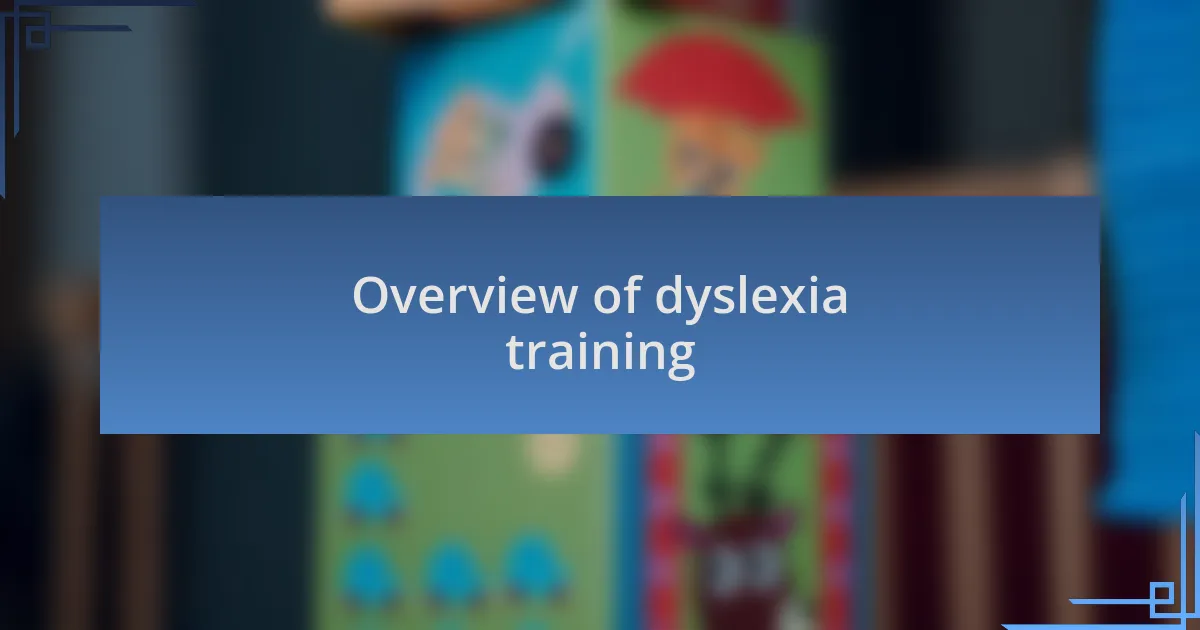
Overview of dyslexia training
Training for individuals with dyslexia encompasses a range of strategies tailored to their unique learning needs. I remember my own early experiences with training programs; they felt like a treasure trove of new techniques that shifted my perspective on learning. It’s fascinating how targeted training can transform challenges into strengths, teaching skills that can support success in academic and everyday tasks.
Central to effective dyslexia training is the emphasis on multisensory learning approaches. I often reflect on how combining visual, auditory, and kinesthetic activities helped me retain information better than traditional methods. Have you ever tried to learn something new using various senses? It truly enhances understanding and retention, making the learning process not just effective, but also enjoyable.
Another key aspect of dyslexia training is building self-advocacy and confidence. I vividly recall a workshop where participants practiced expressing their needs in educational settings. It was a turning point for many of us, inspiring a sense of empowerment. How can we expect individuals to thrive if they don’t feel confident in their abilities? This crucial element of training gives learners the tools they need to navigate their journeys and advocate for themselves effectively.
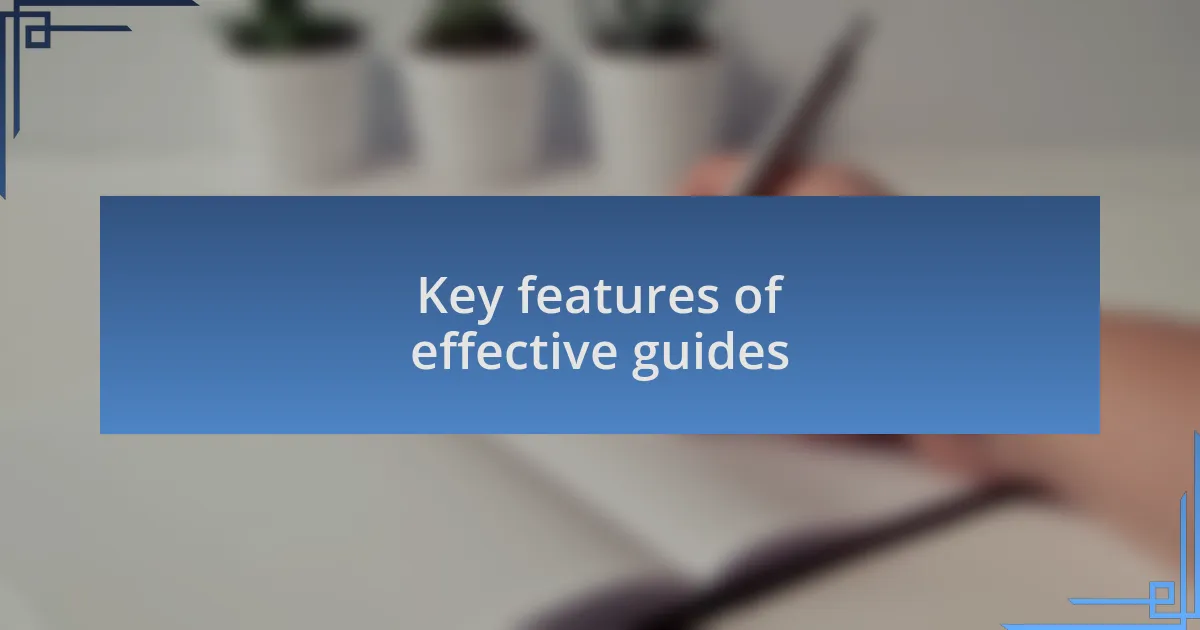
Key features of effective guides
When I think about effective online resource guides, one standout feature is clarity. It reminds me of a guide I once stumbled upon; every section was not just clear but also concise. Have you ever read something convoluted and just felt lost? A well-structured guide should break down complex information into digestible parts, allowing users to navigate easily without feeling overwhelmed.
Additionally, practical examples make guides truly effective. I recall how a particular resource included real-life scenarios that mirrored the challenges I faced. It wasn’t just about theory; it connected me to my experiences. How can a guide resonate if it doesn’t speak to lived experiences? This element grounds the information in reality, making it more relatable and actionable for readers.
Lastly, the ability to respond to questions and offer community support can make a guide exceptional. I once joined an online forum linked to a resource, allowing me to ask questions and share thoughts with others who understood my struggles. Isn’t it comforting to know you’re not alone? Interactive features like forums or Q&A sections enrich the learning experience, fostering a sense of belonging and shared knowledge in the dyslexia community.
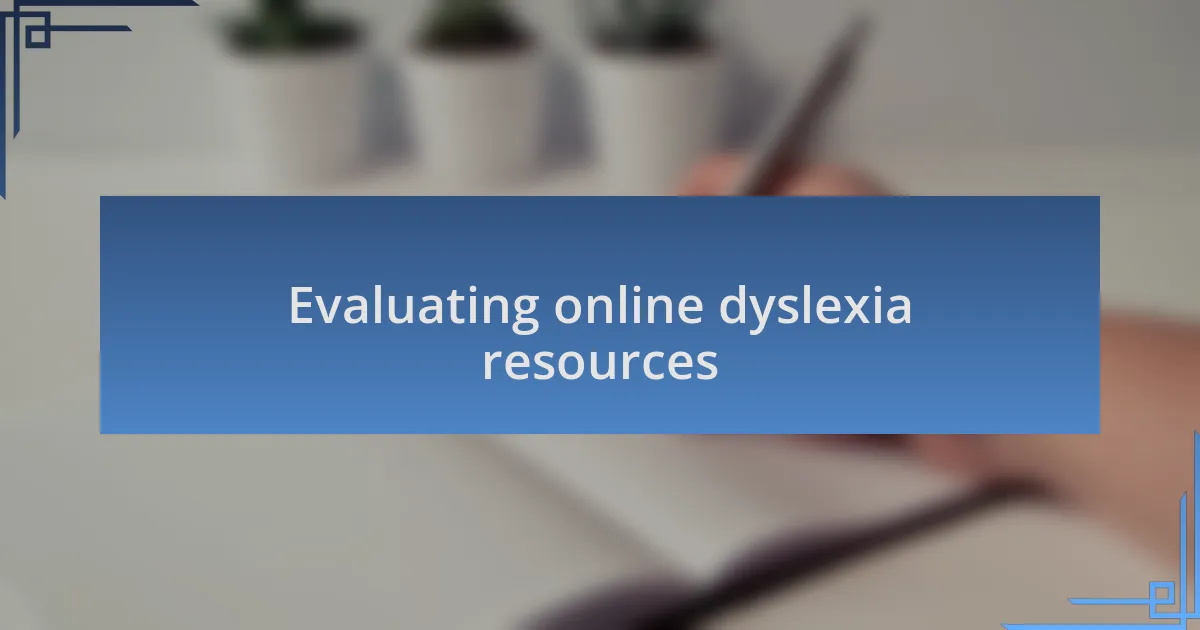
Evaluating online dyslexia resources
When evaluating online dyslexia resources, I often focus on the credibility of the information presented. There was a time I found myself relying on a seemingly helpful site only to later discover it was not backed by credible research. It made me wonder: How can we ensure the resources we use are trustworthy? Seeking sources that reference scientific studies or are endorsed by professionals in the field can provide a much-needed layer of assurance.
Another crucial aspect is the user experience. I remember using a particular online resource that was more frustrating than helpful due to its poor design and navigation. Have you ever clicked multiple times, only to end up lost in a maze of information? A well-designed resource not only enhances accessibility, but it also respects the effort of individuals who are already facing hurdles in learning. Keeping things user-friendly is not just about aesthetics; it’s about showing empathy toward the users’ journey.
Lastly, the community aspect is sometimes overlooked when assessing these resources. I vividly recall a forum attached to a guide where I shared my challenges and received feedback from others who had traversed similar paths. Isn’t it incredible how a shared experience can transform isolation into support? Evaluating resources for their community features can make a significant difference, as they offer not just information but also a network of understanding individuals who are ready to hold space for one another’s struggles.
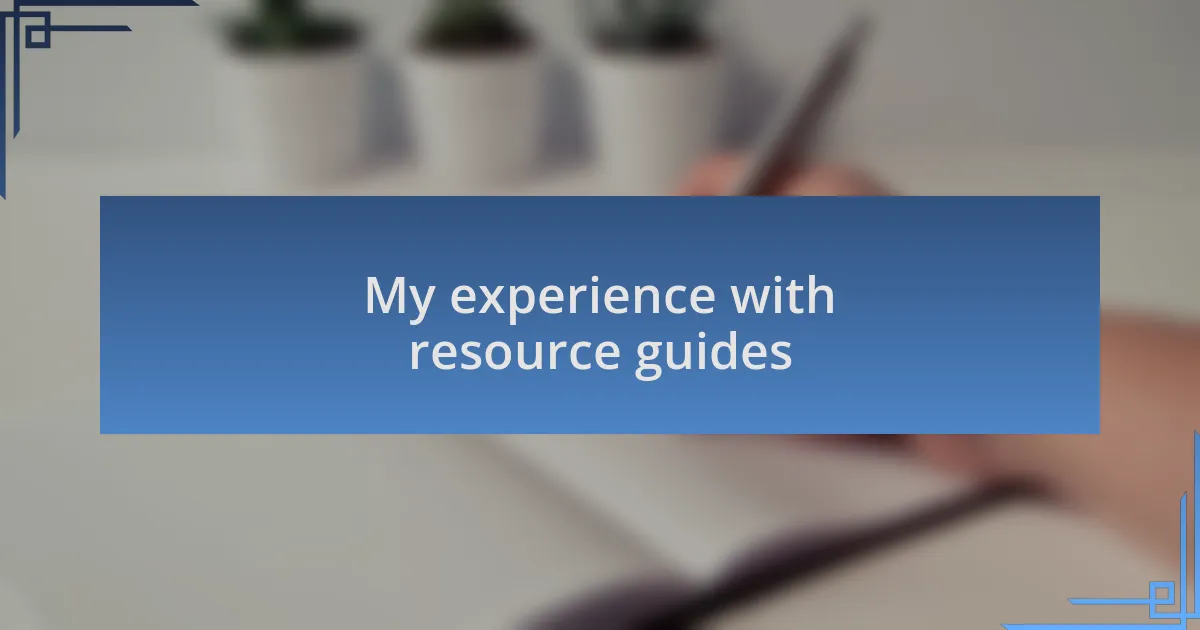
My experience with resource guides
Resource guides can be a game changer, but my experience with them has been a mix of triumphs and pitfalls. I remember stumbling upon a guide filled with worksheets that seemed promising at first. Yet, as I dove in, I realized many of the activities didn’t quite match my learning style. Why is it that some resources resonate while others feel like hitting a wall?
One memorable experience involved a resource hub featuring a variety of video tutorials. I found a particular video on phonics that not only explained concepts clearly but also engaged me visually. That blend of dynamic content really struck a chord with me, showcasing how diverse formats can enhance understanding. Have you ever come across a resource that just clicked? It’s moments like these that remind me of the power of well-curated content in fostering a love for learning.
Conversely, I’ve encountered guides that left me feeling overwhelmed and defeated. A straightforward search led me to a vast online library that was rich in information but lacked practical examples. I found myself questioning: How can I apply all this theory without concrete steps? These experiences highlight the essential balance between theory and practice in resource guides. They must provide not just information, but actionable insights that empower users on their learning journey.
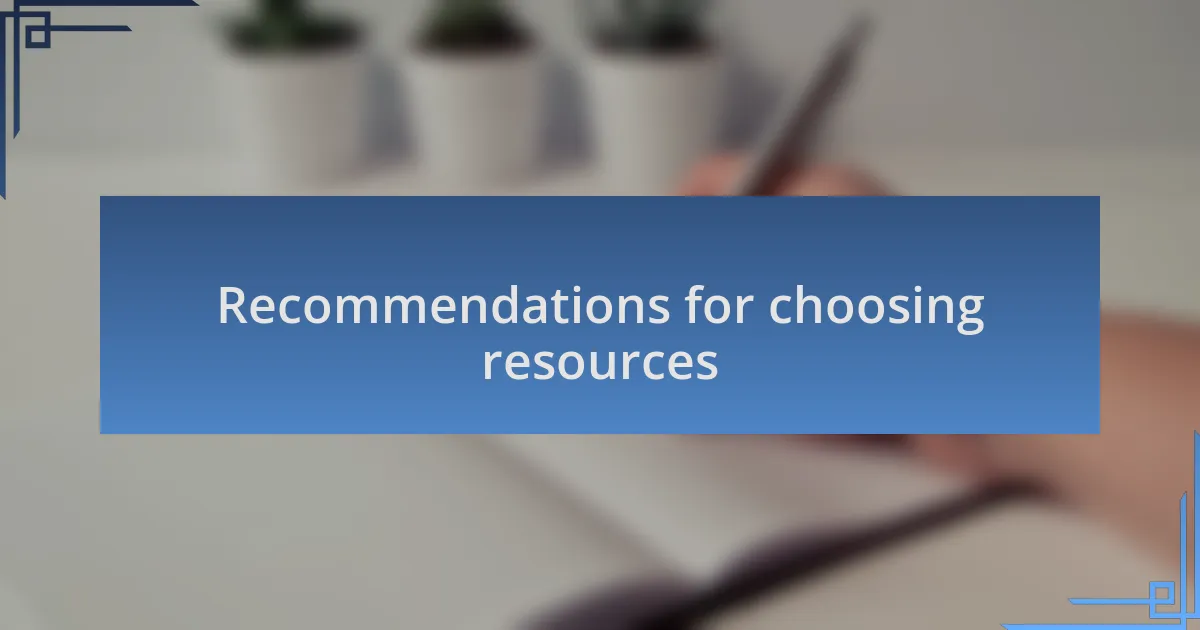
Recommendations for choosing resources
When choosing resources, I recommend looking for those that suit your personal learning style. For instance, I discovered a guide that included a mix of auditory and visual elements, which transformed my approach. I remember the moment I realized that certain types of content could make the material come alive; it was like finding the missing piece of a puzzle.
Next, consider the credibility of the source. I once relied on a popular blog that promised effective strategies, only to find the information was more opinion than evidence-based practice. It’s disheartening to invest time in something that doesn’t deliver actionable advice. Always check if the guide is backed by professionals in the field; it can make a significant difference in your learning journey.
Finally, do not underestimate the value of community feedback. I often browse reviews from others who’ve used a resource before diving in myself. There was a specific forum where users shared their successes and frustrations, which helped me choose a resource that ultimately boosted my confidence. After all, isn’t it reassuring to know that others have paved the way before you?